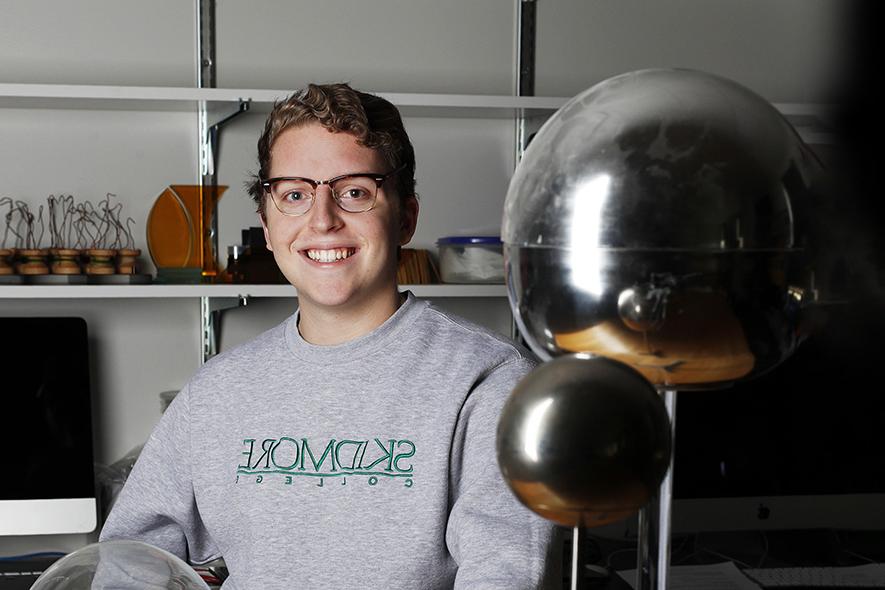在文理学院从事宇宙弦的研究

Like many others, I started my college search not knowing where to look or what to 寻找. 我知道我想主修 物理, but I had no idea what kinds of opportunities and resources might be the most valuable 或者我能在哪里找到他们.
My solution was to be as thorough as possible, and I ended up touring a whopping 26 schools in total, ranging from large R1 (research) universities with tens of thousands of students to smaller schools with only a couple hundred students, and everything 在这两者之间. The search took me to schools in New England, New York, Ohio, Minnesota, 甚至是英格兰.
Despite the traditional association of strong sciences with large universities, I found that the schools that aligned best with what I wanted and needed were small 文理学院. They had better immediate opportunities 为 research and smaller 班级规模. Among these, I admired Skidmore the most of all because it encourages passion-driven projects that bridge a variety of academic disciplines.
In Skidmore’s Physics Department, I found the community that I didn’t know I was looking 为. Physics professors encourage collaboration which fosters a supportive environment where ideas are shared, questions welcomed, and perspectives expanded.
In addition, the academic community promotes interdisciplinary interactions, allowing 物理 enthusiasts to engage with students and faculty from various disciplines and 拓宽我们的知识视野.
Skidmore also recognizes the importance of hands-on experiences in scientific research. Despite being a smaller school, the College offers exceptional opportunities to engage in cutting-edge research projects with accomplished faculty members. 这些研究 experiences not only enhance theoretical knowledge but also foster critical thinking, problem-solving skills, and scientific inquiry — a perfect blend 为 aspiring physicists 像我这样的.
One of my recent classroom experiences really enhanced my appreciation 为 this aspect 学术环境. 在《火博体育官网》这门物理课上,我找到了自我 想要跳出特定课堂作业的范围. 而不是限制 me to the prompt, then Visiting Assistant Professor Jeremy Wachter encouraged me to follow my ambition, and I was able to create a small cloud chamber to observe cosmic 射线与亚原子粒子的相互作用.
Jacob Lord's cloud chamber created to observe cosmic ray interactions.
Beyond this project, 我有 conducted research with Professor of Physics 玛丽·克罗恩·奥德康 物理学副教授 Kendrah墨菲 on 大型星系结构和 a分别是活动星系核.
However, most of my work has involved early universe cosmology, with a specific focus 火博体育宇宙弦.
In fact, I am on track to be among the first undergraduate students in the world to 在宇宙弦研究领域发表论文.
什么是宇宙弦?? 什么是早期宇宙宇宙学?
宇宙弦 are theoretical, one-dimensional strings or ring-shaped objects created after the 宇宙大爆炸在几飞秒(10-15 秒). As far as we know, these strings can only be observed with gravitational 波望远镜. Un为tunately, these telescopes are not yet powerful enough to observe the specific types of gravitational waves we believe cosmic strings produce.
In the meantime, I’m part of a group of researchers (from institutions ranging from Tufts University to the University of the Basque Country) working together to create hypothetical data about the types of gravitational waves produced by strings.
For those less familiar with the field of universe cosmology, imagine the many types of gravitational waves across the cosmos as a symphony orchestra; we are trying to pick out a specific instrument from the cacophony of sound made by this cosmic symphony.
Hypothesizing these waves is akin to theorizing what a trumpet may sound like to someone 谁没听过呢. 在未来,当我们得到宇宙的录音 symphony, we can listen 为 a sound that lines up with our hypothetical trumpet and 很确定地说宇宙弦存在.
宇宙弦的渲染(由Jeremy Wachter提供)
My paper, which will eventually be published in a scientific journal, looks into the code that researchers have used to run cosmic string simulations and modifies it to make it more accurate by accounting 为 diverse cosmic string populations. 我有 done this by creating code that makes a histogram of the probabilities of types of 人口中的字符串. 然后评估我们过去使用过的模拟 在这些新的参数中.
Ultimately, what I’ve accomplished is just one small step 为 the 物理 community, but it represents a giant leap 为ward in our future understandings of cosmic strings. The code 我有 created will pave the way 为 future research into these fascinating 岁月的皱纹.
雅各布·洛德24岁 来自马萨诸塞州梅纳德的物理系学生. 走出教室,他徒步旅行 skis in the local area and is an engaged Hillel member and peer health educator. He likes to unwind with a nice cup of tea from Saratoga Tea and Honey. 他也是船长 of the Physics Department’s peer academic coaching team and is the department’s student 代表. 毕业后,他希望能获得博士学位.D. 在等离子体物理和工作中 in the field of creating renewable energy solutions using nuclear fusion.
